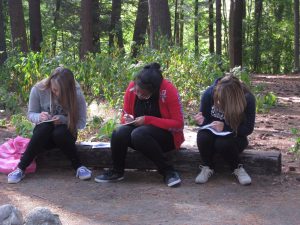
Naomi Volain, Contributing Author
Los Angeles, California, USA
![]() @NaomiVolain
@NaomiVolain
 I’m a natural science teacher. The concept of Space2Learn really resonates for me as I wanted to go to space – as in outer space – to explore and learn. I applied to NASA’s Educator Astronaut Corps and was in the top 10% of finalists. While I didn’t get to go to space, I have made sure that students get outside of indoor classroom spaces into the local environment.
I’m a natural science teacher. The concept of Space2Learn really resonates for me as I wanted to go to space – as in outer space – to explore and learn. I applied to NASA’s Educator Astronaut Corps and was in the top 10% of finalists. While I didn’t get to go to space, I have made sure that students get outside of indoor classroom spaces into the local environment.
Space2Learn for my students has always been outside. Once they get outdoors, their eyes can open up to the world. I feel strongly that if we bring students outdoors they’ll become more keenly aware of the land, water, air and biodiversity that surrounds us. At that point their curiosity awakens and they more actively care about the Earth’s sustainability.
 Placing their feet directly on the Earth makes them global students. The student’s learning space is the surrounding air conditions, what’s in the distance and close up, and in the space between students, as they observe and ask questions. All of this, however, has to be grounded with strong content, competency development, and rigorous expectations. Getting your students outside is fantastic, but you have to be highly organized to make it more than a walk in the park. Here’s a strategy to communicate to students and guide your outdoor education work…
Placing their feet directly on the Earth makes them global students. The student’s learning space is the surrounding air conditions, what’s in the distance and close up, and in the space between students, as they observe and ask questions. All of this, however, has to be grounded with strong content, competency development, and rigorous expectations. Getting your students outside is fantastic, but you have to be highly organized to make it more than a walk in the park. Here’s a strategy to communicate to students and guide your outdoor education work…
- Safety concerns/organization – so no one gets lost
- Objective for the outdoor learning space lesson
- Student tasks and outputs – students must produce something in writing, data collection, drawing, etc.
- Reflection – what did it all mean, anyway? Why do we go to outside places to make meaning of our world?
 High school science students learn outside. Why not learn science where the science naturally exists? Biology, botany, ecology, environmental science are just some of the topics to explore. I’m inspired to see students engaged in outdoor activities using the strategy above as the conduct cloud observations, tree measurements, biodiversity mapping, soil sampling, specimen collection and more.
High school science students learn outside. Why not learn science where the science naturally exists? Biology, botany, ecology, environmental science are just some of the topics to explore. I’m inspired to see students engaged in outdoor activities using the strategy above as the conduct cloud observations, tree measurements, biodiversity mapping, soil sampling, specimen collection and more.

Naomi Volain is a natural and life sciences high school teacher. Her hands-on, highly interactive classes focus on environmental literacy and outdoor education with curiosity and rigor. Her awards include the Presidential Award for Excellence in Math and Science, Presidential Innovation Award for Environmental Educators and 2015 Top 10 Finalist for the Global Teacher Prize. Naomi is writing a webpage dedicated to plants as solutions to environmental change. She lives in Los Angeles, California.